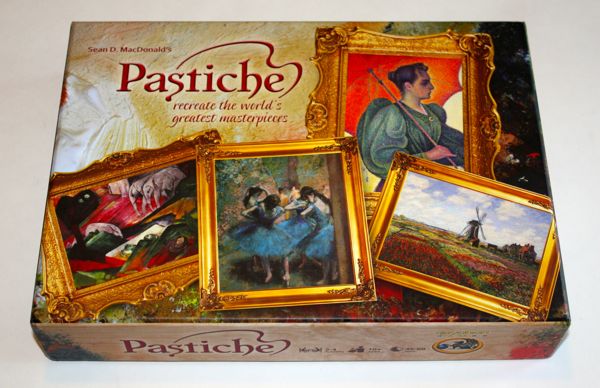
Did you ever try to paint with watercolors when you were young? Did your teacher put one of those red, blue, yellow, and black sets of paints on your list of school supplies? Or maybe you were lucky enough to have a set with 8 different colors!
Pastiche may remind you of your attempts at mixing those watercolors. But “mixing” colors in Pastiche is a lot easier than trying to do the same with real paints. You’ll probably think it’s more fun in this game too.
Let’s take a look at painting in Pastiche to help you decide if this is a game you’d like to try with your friends and family.
What Bits Do You Get to Play With in Pastiche?
Pastiche comes with some nice components, especially if you get the newer International version (which unfortunately I don’t have). There is a large board showing an artist’s palette on which you stack the various colors of cards (Palette Cards).
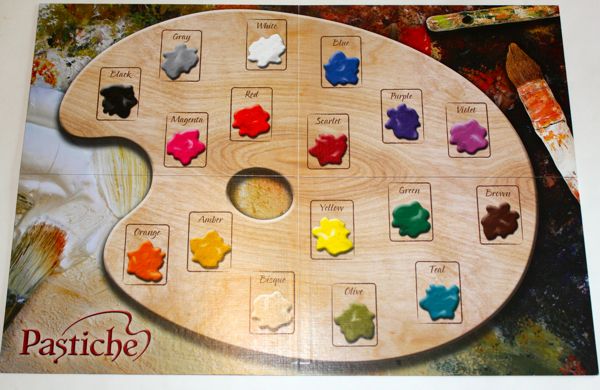
We found that this board is really oversized. The spaces for the cards could be much closer together. That would at least leave room for the stack of paintings. As it is, you can put the paintings on the board, if you wish, but there’s no designated space for them.
The smallish cards show paint daubs and point values. There are several, but differing, amounts of each in primary (red, blue, yellow), secondary (green, orange, violet), tertiary colors and more.
The 34 paintings cards (Commission Cards) are very thick (thicker, and thus heavier, than they really need to be) and show a gorgeous artwork, information about it and its painter, colors needed to create the painting, and point values. I acquired my copy of Pastiche in a trade. It has some paintings from the first edition and some from the second (International) edition. It’s not optimal for playing, but it works as long as everyone knows this ahead of time.
Finally, there are the 54 hex tiles (Palette Hexes) that only have red, blue, and yellow daubs on them. One of these is a triple hex that is the starter tile that you set in the center of the playing area at the beginning of the game.
A piece not technically used in the game but nonetheless extremely useful is the player reference card (4 of them). On one side, it shows how to take your turn. On the other side, it shows how to mix primary colors to make other colors.
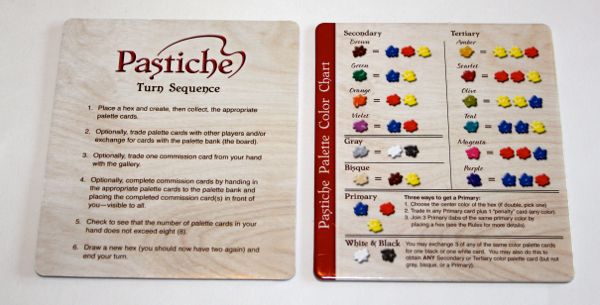
The one item notably missing from the first edition is a set of easels on which you can set your paintings. This problem was rectified in the second edition.
How Do You Play Pastiche?
Before starting the game, each player (2 to 4 of them) gets two hex tiles, two painting cards, and four palette cards. The rest of the hexes are turned face down in a draw pile. (They should not be stacked.) Four other painting cards are turned face up to make them available to all players. As hinted at above, the triple hex tile goes in the center of the table.
On your turn, you first play on of your two hex tiles adjacent to the hex tile(s) already played to the table. This action will make two or more primary colors match up from your tile to those previously played.
If a place where just two colors come together shows the same two primary colors (for example, two reds), you get nothing. So you try to prevent that arrangement when placing your hex tile.
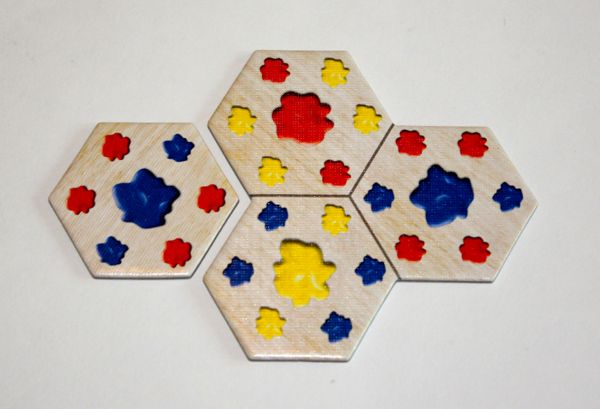
In all other cases, you’ll get a palette card, depending on which two or three colors match. For example, if two blues and a yellow meet, you get to take a teal palette card into your hand.
If you think about it, you’ll realize that there’s doesn’t seem to be a way to get a primary color into your hand using the above method. Actually, there are several ways to get primaries. If three of the same primary match, you get that color.
In the center of each hex is a single or double daub of paint. Instead of taking cards for the matching daubs, you can take just one card of a primary shown in the center of your hex tile.
If that center daub doesn’t show the color you really need, you can take it anyway and then trade it and a penalty card from your hand for the color you do want.
Finally, you might be able to trade for a primary (or any other color) with other willing players.
The goal of all this card gathering is to get the paint colors shown on one of your painting cards. When you manage to acquire them, you can reveal the painting and the matching cards. You score the points shown on the painting and draw a new painting from the stack.
If you don’t like one of your paintings, you can trade it in for one of the four available from the beginning of the game. One reason to do so, is to get two paintings by the same artist. If you complete each of these, you get bonus points at the end of the game.
The game ends shortly after one player has finished enough paintings with values totaling the required amount, which depends on the number of players. After one player has done this, everyone gets one more turn.
If you have cards in your hand at the end of the game that could have been used toward completing one of your paintings, you get to add the values on those cards to your final score.
There are a few other little rules not covered here. They won’t affect your thoughts about the game significantly, so I’ll leave them for you to discover when you get your own copy.
So What Do You Think about Pastiche?
I like Pastiche. It’s simple to teach and fairly quick to play. Experienced players should easily be able to complete a game in less than an hour – perhaps even closer to half an hour sometimes.
There’s not much interaction between the players, even though there could be due to the card trading rule. In practice, this just doesn’t seem to happen very often. Each player usually has cards he needs for his own paintings and isn’t willing to give them up. And that’s fine. The game still plays well with everyone doing his own thing.
Despite the design flaws mentioned earlier (which in aggregate make a hefty box necessary), the game looks beautiful. One other feature we wish the box designers had thought of was making vertical spaces for the different colors of palette cards. That would make setup on the large palette board much easier.
That said, the actual box insert is well made. There is a space for everything – even if you do have to put all the palette cards into two stacks.
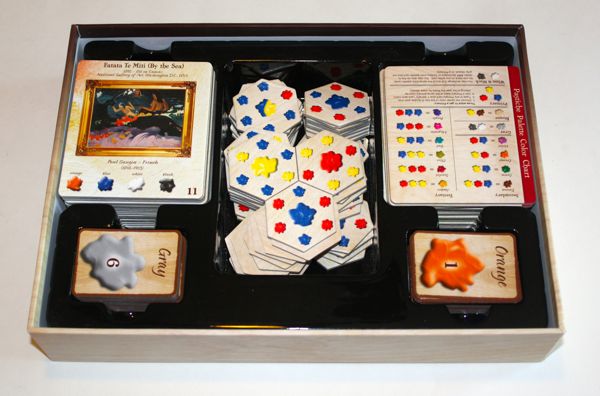
Pastiche is a good family game. It’s light, non-confrontational (for the most part), and fun. On top of it all you discover how to make magenta, olive, and amber and learn the difference between violet and purple. What more could you want from a game!
